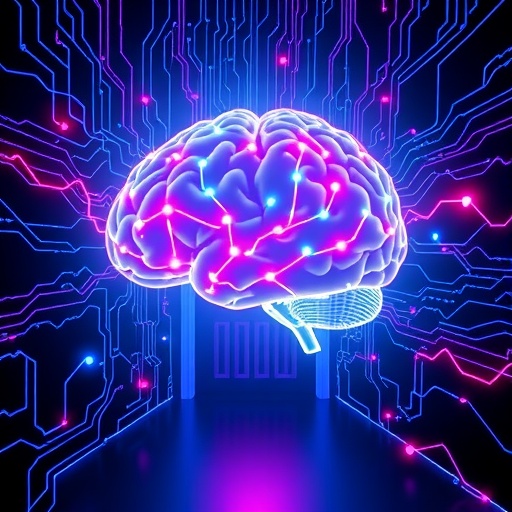In the intricate landscape of the brain’s communication network, electrical signals power the synaptic dialogue that underpins cognition, learning, and memory. At the heart of this complex system reside NMDA (N-methyl-D-aspartate) receptors, specialized ion channels that regulate ionic flow upon activation. These receptors must maintain a precise balance in their activity—too much or too little ion permeability can destabilize neuronal circuits, contributing to cognitive decline and neurodegenerative diseases such as Alzheimer’s. A groundbreaking study led by structural biologist Hiro Furukawa and postdoctoral researcher Hyunook Kang at Cold Spring Harbor Laboratory is illuminating the molecular choreography that governs NMDA receptor gating, potentially opening new avenues for therapeutic intervention.
NMDA receptors function as critical gatekeepers by responding to neurotransmitters and modulating the ionic currents that propagate electrical signals across neurons. These ion channels exhibit a remarkable capacity for allosteric regulation, where molecules binding at sites distinct from the ion conduction pathway influence the receptor’s opening state. Furukawa’s team has harnessed cutting-edge cryo-electron microscopy to visualize these receptors in unprecedented detail, capturing the dynamic conformational states responsible for their function. Their work sheds light on how endogenous neurosteroids and synthetic modulators fine-tune receptor activity by stabilizing specific conformations of receptor subunits.
The study reveals that NMDA receptors consist of four rod-like transmembrane domains that pivot to control the channel’s pore. When a neurosteroid known as 24S-hydroxycholesterol (24S-HC)—a natural brain compound—binds to the receptor, it orchestrates a fully open conformation, allowing an unimpeded flow of charged ions such as sodium and calcium. This state enhances synaptic transmission and facilitates neuronal communication crucial for learning and memory. Conversely, synthetic allosteric regulators act like molecular “doorstops,” locking certain receptor elements in intermediate positions to produce a partially open state.
This partially open conformation allows selective ion permeability, preferentially permitting sodium ions to flow through while restricting calcium influx. The distinction is pivotal: while calcium ions serve essential roles in synaptic plasticity and memory consolidation, excess intracellular calcium can trigger neurotoxic cascades leading to neuronal degeneration. The ability to modulate NMDA receptor permeability to calcium without disrupting sodium flow presents an elegant strategy to prevent excitotoxicity while preserving essential signaling.
Collaborating with researchers at Emory University, Furukawa’s group quantitatively assessed ion currents through fully and partially open receptor states. Their electrophysiological measurements confirmed the structural insights, demonstrating that full channel opening results in a robust surge of ionic current, whereas the partially open state maintains moderated activity. This nuanced modulation highlights the physiological importance of allosteric regulation and suggests that targeted therapies could mimic or enhance natural regulatory mechanisms.
The investigation delved into the binding interactions between the receptor and its regulators, analyzing how the neurosteroid 24S-HC exerts its effects at the molecular level. Cryo-EM structures identified specific interfaces where 24S-HC stabilizes the receptor’s open state by inducing steric and electrostatic modifications that realign the transmembrane helices. These alterations facilitate the expansion of the ion conduction pathway, effectively removing steric blockades that could hinder ion flow.
In contrast, synthetic regulators were shown to interact with alternative binding pockets on the receptor, restricting the mobility of select transmembrane domains. This molecular tug-of-war between activation and inhibition underscores the versatility of NMDA receptors as pharmacological targets. The potential to design compounds that selectively modulate receptor states holds promise for tailored interventions in neurological disorders where disrupted receptor function is implicated.
The broader implications of this research extend to understanding the physiological roles of endogenous neurosteroids in brain health. Neurosteroids like 24S-HC have multifaceted functions, including modulating synaptic plasticity and neuroprotection. By characterizing their modes of action on NMDA receptors at atomic resolution, scientists can better appreciate how these molecules contribute to neural homeostasis and cognitive resilience.
Furukawa emphasizes the therapeutic potential stemming from these findings, envisioning precision drugs that harness the principles of allosteric regulation. “Fine control over calcium permeability could revolutionize treatments for neurodegenerative diseases and acute neurological injuries such as strokes,” he explains. The ability to ‘dial down’ excitotoxic calcium signaling while maintaining sodium-driven electrical activity could safeguard neurons without compromising brain function.
Additionally, this research paves the way for further exploration into the diversity of NMDA receptor subtypes distributed throughout the brain. Variations in subunit composition, regulatory site accessibility, and neurosteroid affinity suggest a rich landscape of receptor modulation yet to be charted. Such complexity promises both challenges and opportunities for neuroscientists aiming to decode the molecular logic of synaptic signaling.
The convergence of structural biology, electrophysiology, and pharmacology in this study exemplifies a multidisciplinary approach to tackling neurological disorders. By delineating how natural and synthetic modulators influence receptor gating at the molecular level, the researchers provide critical insights that bridge fundamental neuroscience with clinical aspirations.
Ultimately, the analogy of a “chemical doorstop” within the brain encapsulates the transformative potential of this breakthrough. As researchers continue to deconstruct the mechanisms controlling NMDA receptor activity, they inch closer to innovative treatments that could mitigate cognitive decline, enhance mental health, and improve quality of life for millions affected by brain diseases.
Subject of Research: NMDA receptor gating mechanisms and their regulation by neurosteroids and synthetic modulators
Article Title: Molecular Gatekeepers of the Brain: How Neurosteroids and Synthetic Regulators Control NMDA Receptor Activity
Web References:
http://dx.doi.org/10.1038/s41586-025-09695-4
Image Credits: Furukawa lab/Cold Spring Harbor Laboratory
Keywords: NMDA receptors, Structural biology, Steroid hormones, Allosteric regulation, Ion channels, Transmembrane proteins
Tags: allosteric modulation of receptorsbrain communication networkscognitive decline researchcryo-electron microscopy in neuroscienceion channel regulationneurodegenerative disease mechanismsneurosteroid influence on receptorsneurotransmitter signaling pathwaysNMDA receptorsreceptor gating dynamicsstructural biology breakthroughstherapeutic interventions for Alzheimer’s





